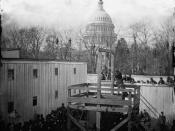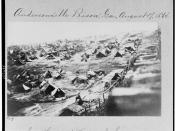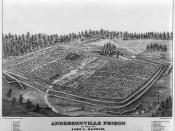Although Turner Network Television claims to have told 'The Great Untold Story of the "Civil War"' through its recent production, 'Andersonville', the true untold story is the other way around: that of the plight of Southern captives confined in Federal prison camps. Here is their story.
At Illinois's 'living grave', Alton Prison, the Confederates were housed in the former Illinois State Penitentiary, which through the efforts of reformer Dorothea Dix, had been condemned as unfit for human habitation. Andersonville, on the other hand, was chosen for the healthfulness of the site and the supply of fresh water which was adequate for the projected number of future prisoners. Although the city of Alton was a produce centre, hundreds of prisoners suffered from the ravages of scurvy. From just the right corner, with bloody, diseased gums and teeth falling out, the ailing prisoners could peer out over the 30 foot high prison walls at neighbouring hilltops covered with pear, peach, and crabapple trees.
Prisoner entreaties to the guards for some of the trees' life-saving fruit were cruelly denied.
"At Elmira, however, the chief surgeon, E. L. Sanger, who boasted that he had 'killed more "Rebs" than any soldier at the front', resigned his post in order to avoid court martial for his criminal treatment of prisoners." Deaths at Alton were not accurately recorded, yet at Andersonville every death was carefully registered and each grave was meticulously marked by order of Commandant Captain Henry Wirz who explained that he wanted any Northern mother who came down looking for her son, to find him. According to an Illinois State Office of Tourism publication, estimates of the death rate at Alton reach as high as over 42%, nearly doubling the 24% rate at Andersonville. At Camp Douglas in Chicago, intoxicated guards frequently inflicted arbitrary punishments upon blameless Southern captives. Once, when a guard slipped and fell, a North Carolinian, who could not contain his laughter, was shot and killed on the spot. For the crime of 'spitting too much' prisoners from Barrack #10 were made to sit naked on the ice. Confederates were tied up by their thumbs or were forced to ride the infamous 'Morgan's Mule'a twelve foot high carpenter's saw horse. With weights attached to the prisoners' legs, the sharpened top plank would tear through the flesh leaving the prisoners unable to walk for days. Harsh and undue punishment? Morgan's Mule was a particular favourite of the tourists who paid to climb the tourist observation tower and gaze out at the 'Rebs'. On days when no punishment was scheduled, innocent prisoners had to ride the Mule solely for the entertainment of the paying tourists.
In February 1863, out of 3,884 POWs at Camp Douglas, 387 died. This mortality rate of ten percent of the entire prison population in one month alone was never surpassed by any other prison, North or South. Elmira, dubbed 'Hellmira' by the Confederates, paralleled Andersonville in length of existence. Both were late-war prisons, yet the 33 percent death rate at this New York state prison was considerably higher than the rate at the more well-known Georgia stockade. After rations were reduced to bread and water, Southern prisoners resorted to eating rats and searching in the sewer for scraps of food. According to Confederate law, however, Federal POWs were given the same rations as the Confederate soldier in the field. Prisoners' tents at Elmira were ordered struck at morning roll call and could not be pitched again until evening, leaving the hapless Southerners at the mercy of the elements for the entire day. At Andersonville, on the other hand, while the Confederacy was unable to provide shelter for such vast numbers of prisoners, it did not prohibit prisoner-made shelters (shebangs) which, as contemporary photographs illustrate, literally covered the prison enclosures.
"In their emaciated condition POWs were tormented by their guards who forced them to kneel and pray to Abraham Lincoln, to run, to dance or to stand on one foot for more than a half-hour." Not withstanding TNT's portrayal of Andersonville commandant Wirz as (according to Newsweek magazine) an 'aging (Wirz was 42 at the onset of hostilities), barbarous, pre-Nazi', responsible historians now regard Wirz as an innocent scapegoat and victim of post-war hysteria. At Elmira, however, the chief surgeon, E. L. Sanger, who boasted that he had 'killed more "Rebs" than any soldier at the front', resigned his post in order to avoid court martial for his criminal treatment of prisoners. At Johnson's Island Prison in Ohio African-American Confederate POWs were denied their rations in an attempt to force them to desert, which they refused to do. It was their white comrades-in-arms who came to their rescue by sharing their own meagre rations. Point Lookout in Maryland, the largest prison in the North, housed nearly 20,000 by war's end. POWs there lived in leaky, U.S. Army-reject tents. The often poorly clad Confederates had to huddle together all day or run to prevent actually freezing to death. At one time, fully one-third of the prisoners lacked a single blanket. The Southern captives slept on the bare ground and on every cold night from four to seven prisoners froze to death. In their emaciated condition POWs were tormented by their guards who forced them to kneel and pray to Abraham Lincoln, to run, to dance or to stand on one foot for more than a half-hour.
Beginning in late 1864 Rock Island Prison in Illinois was likened to Andersonville. Stories of the atrocities of Rock Island appeared even in The New York Daily News which described the rations as '1/3 lb. of bread and 2" square of meat supplemented when possible by dogs, rats and mice. Many are nearly naked, bare-footed, bareheaded and without bedclothes. They are thus exposed to the ceaseless torture from the chill and the pitiless winds of the Upper Mississippi River. Death is the only comforter and he appears frequently.' The guards at Camp Chase in Columbus, Ohio, took pleasure in watching the starving Confederates scuffle for apple cores and melon rinds that they threw out into the prison streets. Prisoners were hanged by the toes or forced to stand barefoot in the snow. Even local Columbus newspapers said that the North could howl about Andersonville, but it should stop and look at Camp Chase. Indeed, the record of prisoner deaths in one day at Camp Chase surpasses the record, percentage-wise, at the larger Andersonville prison.
Although perpetrated upon the dead, it was at Camp Chase that occurred the most singular atrocity of any prison, North or South: prisoners' bodies were sold to a medical school in Cleveland. Confederate authorities conscientiously endeavoured to relieve the conditions in the Southern prisons. Confederate President Jefferson Davis sent a delegation of prisoners, paroled from Andersonville, to Washington to plead for resumption of the Prisoner Exchange Program (which would have relieved most of the suffering). Abraham Lincoln refused to see the men and the Cabinet member who did meet with the Andersonville delegation scornfully admonished them that they did their country more good by returning whence they had come. ('Avenge Andersonville' was, by then, serving the Lincoln administration as a rallying cry against sagging enlistments for its highly unpopular war.) Moreover, Jefferson Davis's humane offer to purchase, in gold, medicine and supplies that were unavailable in the South, for the sole use of the prisoners at Andersonville, received no response whatsoever from Washington.
The mini-series 'Andersonville' ends with the prisoners headed for an exchange that didn't happen. The program fails to mention the reason: that the United States Exchange officials refused to accept the prisoners. In 1866, United States Secretary of War, Edwin M. Stanton, released the following figures regarding prisoners of war: 26,436 Confederate dead in Union prisons; 22,576 Union dead in Confederate prisons. Thus nearly 18% more Confederates lost their lives in Northern prisons than vice versa. Bearing in mind that the suffering in the Southern prisons took place in a war-torn South, while the misery and deprivation endured by Confederate prisoners in Northern prison camps occurred in a land of plenty, it would seem that Ted Turner picked the wrong prison.
Kay Reyes is Commandant-In-Chief of the Confederate Prisoner of War Society, PO Box 702,





